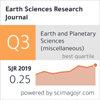Study on large-gradient deformation of mining areas based on InSAR-PEK technology
IF 0.5
4区 地球科学
Q4 GEOSCIENCES, MULTIDISCIPLINARY
引用次数: 0
Abstract
To solve large-gradient deformation in mining areas unavailable by SAR data, a method combining PIM Exponent Knothe (PEK) model and InSAR technology (InSAR-PEK) was proposed to predict the mining-induced subsidence and obtain the large-gradient deformation dynamically. Firstly, the maximum subsidence value predicted by the probability integration method was combined with SAR data, and the subsidence values in the initial and residual periods were obtained. Secondly, three groups of power exponent Knothe function parameters were obtained, including csar and ksar based on SAR data, clevel_wz, and klevel_wz based on leveling data over a complete observation period, and clevel_bf and klevel_bf based on the elimination of the leveling data in the main period. Finally, the predicted values of the three groups of parameters were compared with the measured data, respectively, and the root mean square errors (RMSE) were obtained. The engineering example verified that RMSEs were 28.1mm~91.7mm in the main period and 30.9mm~58.7mm in the whole period estimated by the InSAR-PEK method. The results showed that the subsidence values in the main period were relatively stable by the InSAR-PEK method, and some points' prediction accuracy was better than that of leveling data. The predicted values obtained by the InSAR-PEK method and those extracted by SAR were compared with the measured values. In the main period, the values extracted by SAR differed greatly from the measured values, which were false values. However, the predicted values by the InSAR method were close to the measured values, which can be used to independently get subsidence values in the main period from SAR data.基于InSAR-PEK技术的矿区大梯度变形研究
为解决SAR数据无法提供的矿区大梯度变形问题,提出了PIM指数Knothe (PEK)模型与InSAR技术相结合的采动沉陷预测方法,动态获取采动沉陷大梯度变形。首先,将概率积分法预测的最大沉降值与SAR数据相结合,得到初始期和剩余期的沉降值;其次,得到三组幂指数Knothe函数参数,包括基于SAR数据的csar和ksar,基于整期水准数据的clevel_wz和klevel_wz,以及基于主期水准数据消除的clevel_bf和klevel_bf。最后,将三组参数的预测值分别与实测数据进行比较,得到均方根误差(RMSE)。工程实例验证了InSAR-PEK方法估算的主周期均方根误差为28.1mm~91.7mm,全周期均方根误差为30.9mm~58.7mm。结果表明,InSAR-PEK方法在主要时期的沉降值相对稳定,部分测点的预测精度优于水准资料。将InSAR-PEK方法得到的预测值与SAR提取的预测值与实测值进行比较。在主要时段,SAR提取值与实测值相差较大,为假值。而InSAR方法预测的沉降值与实测值较为接近,可用于从SAR数据中独立获取主要时段的沉降值。
本文章由计算机程序翻译,如有差异,请以英文原文为准。
求助全文
约1分钟内获得全文
求助全文
来源期刊

Earth Sciences Research Journal
地学-地球科学综合
CiteScore
1.50
自引率
0.00%
发文量
0
审稿时长
>12 weeks
期刊介绍:
ESRJ publishes the results from technical and scientific research on various disciplines of Earth Sciences and its interactions with several engineering applications.
Works will only be considered if not previously published anywhere else. Manuscripts must contain information derived from scientific research projects or technical developments. The ideas expressed by publishing in ESRJ are the sole responsibility of the authors.
We gladly consider manuscripts in the following subject areas:
-Geophysics: Seismology, Seismic Prospecting, Gravimetric, Magnetic and Electrical methods.
-Geology: Volcanology, Tectonics, Neotectonics, Geomorphology, Geochemistry, Geothermal Energy, ---Glaciology, Ore Geology, Environmental Geology, Geological Hazards.
-Geodesy: Geodynamics, GPS measurements applied to geological and geophysical problems.
-Basic Sciences and Computer Science applied to Geology and Geophysics.
-Meteorology and Atmospheric Sciences.
-Oceanography.
-Planetary Sciences.
-Engineering: Earthquake Engineering and Seismology Engineering, Geological Engineering, Geotechnics.
 求助内容:
求助内容: 应助结果提醒方式:
应助结果提醒方式:


